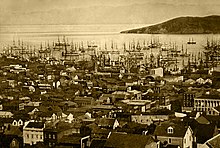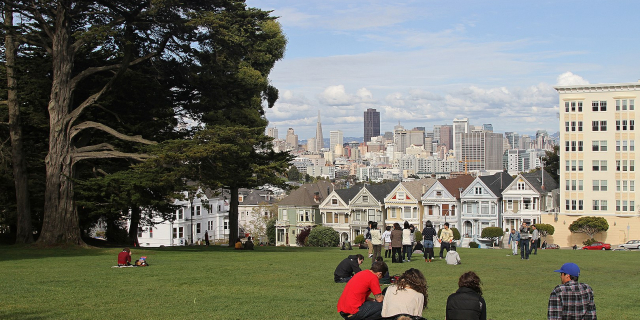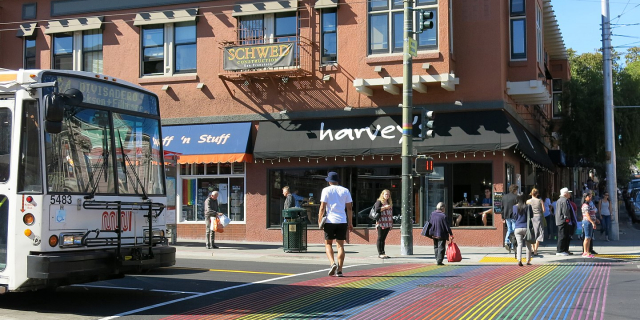The Port of San Francisco is a semi-independent organization that oversees the port facilities at San Francisco, California, United States. It is run by a five-member commission, appointed by the Mayor and approved by the Board of Supervisors. The Port is responsible for managing the larger waterfront area that extends from the anchorage of the Golden Gate Bridge, along the Marina district, all the way around the north and east shores of the city of San Francisco including Fisherman's Wharf and the Embarcadero, and southward to the city line just beyond Candlestick Point. In 1968, the State of California, via the California State Lands Commission for the State-operated San Francisco Port Authority (est. 1957), transferred its responsibilities for the Harbor of San Francisco waterfront to the City and County of San Francisco / San Francisco Harbor Commission through the Burton Act AB2649. All eligible State port authority employees had the option to become...Read more
The Port of San Francisco is a semi-independent organization that oversees the port facilities at San Francisco, California, United States. It is run by a five-member commission, appointed by the Mayor and approved by the Board of Supervisors. The Port is responsible for managing the larger waterfront area that extends from the anchorage of the Golden Gate Bridge, along the Marina district, all the way around the north and east shores of the city of San Francisco including Fisherman's Wharf and the Embarcadero, and southward to the city line just beyond Candlestick Point. In 1968, the State of California, via the California State Lands Commission for the State-operated San Francisco Port Authority (est. 1957), transferred its responsibilities for the Harbor of San Francisco waterfront to the City and County of San Francisco / San Francisco Harbor Commission through the Burton Act AB2649. All eligible State port authority employees had the option to become employees of the City and County of San Francisco to maintain consistent operation of the Port of San Francisco.
The Port of San Francisco lies on the western edge of the San Francisco Bay near the Golden Gate. It has been called one of the three great natural harbors in the world, but it took two long centuries for navigators from Spain and England to find the anchorage originally called Yerba Buena: a port, as was said in its early days, in which all the fleets of the world could find anchorage.
The port area under the commission's control comprises nearly eight miles of waterfront lands, commercial real estate and maritime piers from Hyde Street on the north to India Basin in the southeast. The list of landmarks under port control include Fisherman's Wharf, Pier 39, the Ferry Building, Oracle Park (formerly AT&T Park, SBC Park and Pacific Bell Park), located next to China Basin and Pier 70 at Potrero Point. Huge covered piers on piles jut out into San Francisco bay along much of the waterfront, bordered by the Embarcadero roadway. In 2015, the city, acting through the Port of San Francisco, launched the San Francisco Seawall Earthquake Safety and Disaster Prevention Program (Seawall Program).
 San Francisco in 1849
San Francisco in 1849The first landing place on the north-eastern tip of the San Francisco peninsula was a rocky promontory below Telegraph Hill later known as Clarke's Point that jutted into the San Francisco Bay at the line of what is now Broadway and Battery Streets. Yerba Buena Cove swept inland from the subsequently named Clarke's Point to as far as Montgomery Street to the west, and further south and east to Rincon Point at the south of Market area at the foot of Folsom and Spear streets.
The founding padres of Mission Dolores and the other northern California missions found the jetty at Clarke's Point a convenient landing for their commerce in hides and tallow. It is the same location where Russian ships anchored to load supplies of meat and grain. Early European visitors were the British Raccoon in 1814 and the French frigate Artemise in 1839. The sloop USS St. Louis, which arrived in 1840, was the first warship to fly the American flag in San Francisco Bay. On July 9, 1846, the sloop USS Portsmouth gave a 21-gun salute and Captain John Berrien Montgomery and his detachment rowed ashore and hoisted the American flag on the Mexican flagpole in the small settlement's plaza, later named Portsmouth Square in honor of the ship.
The earliest development of a port in San Francisco, two and a half miles east of the Presidio, was under the Mexican regime, begun in 1835 as the town of Yerba Buena. Before this time, the port at Monterey was considered the official port of entry to California.
 San Francisco Harbor in 1851
San Francisco Harbor in 1851Captain Richardson erected the first abode of a European on the hill overlooking the Bay. He became the first harbor master by appointment of the Governor Mariano Guadaloupe de Vallejo. Whalers took umbrage at the taxes charged by the Mexican governor Manuel Micheltorena in 1843, and the outright banning of their trading in the port, then relocated from San Francisco to the Hawaiian Islands.
Commodore John D. Sloat claimed California for the United States on July 7, 1846, during the Mexican–American War, and Captain John B. Montgomery arrived to claim Yerba Buena two days later. In 1847, the first American alcalde, Lt. Washington Allon Bartlett changed the name from Yerba Buena to San Francisco, "so that the town may have the advantage of the name given on the public map".
The United States governor of the newly occupied territory of California, General Stephen W. Kearny, renounced the rights of eminent domain of the American government in favor of the city of San Francisco.[clarification needed] The early city built up on the west side of Yerba Buena Cove around Portsmouth Square.
Immediately, the municipality of San Francisco was given the right, by General Kearney acting as governor of California, to sell "water lots" in the tidelands between Clarke's Point and Rincon Point so the city might gain revenues from the sale. At the same time, the owner of the land at the foot of Telegraph Hill, W. S. Clarke built a timbered wharf and the location became known as Clarke's Point. Later, a substantial wharf 750 feet (229 m) long and 60 feet (18 m) wide was erected to the depth of water, 26 feet (8 m), made the landing available to deep water ships. this project was followed by other wharves built below Broadway and Clay streets, and at Commercial street.
 The Shoreline of San Francisco in 1853
The Shoreline of San Francisco in 1853When gold was discovered in California, the first hulk of an old iron revenue steamer, the James K. Polk, was beached at the foot of the bluff near Clarke's Point and became the foundation of the first real passenger landing in the city. It was at this site that the population of San Francisco met the Pacific mail liner the Oregon to receive the official announcement that California had been admitted to the Union. The bluff at the point was quickly leveled and on the land created a wharf was built that became the first regular berthing place, for a short time, for the Pacific mail steamships. Whatever products came to California, and whatever California produced, had to be carried by ship. In the first year of the gold rush, hundreds of ships were beached and abandoned in the tidal flats of Yerba Buena Cove, and numerous ships were run aground to become parts of the city itself. In 1853, the Vallejo Street wharf lease was granted, and a larger wharf was built.
In the ensuing years, the state legislature passed bills concerning the sale of water lots and authorizing the city to construct wharves beyond its boundary and to set wharfage rates. The battles over control of the waterfront, water lots, and docking privileges began. The great Central Wharf was built in 1849, named for the central wharf in Boston, and was located where Commercial street is now. Eventually a huge forest of masts from a fleet of abandoned vessels filled Yerba Buena Cove. By 1851, the Central Wharf had ten times more business offered than it could handle, and many new wharves were struck into the bay, including those at Market, Sacramento, Washington, California, Clay, Jackson and Pacific Streets. The filling of Yerba Buena Cove and extensive corruption and legislation led to a period, during the gold rush, when major portions of the city were built on water lots, reclaimed by hook or by crook, on pile driven and rough planking overlain. Early San Francisco was a wharf city of planks and sheds and subject to devastating fires. Half the early city was built on trembling wharves and the scrub and sandy hills were not appreciated, amongst them only a few abodes and scattered tents were found. The early wharves and their buildings fell into the bay and by 1857, the waterfront was a jumble of abandoned ships and rickety piers. Businesses looked for more solid facilities.
Two wharves of notice projected out into the bay from the foot of Taylor street: McMahon's Wharf, and Meiggs Wharf. They had T- and L-shaped extensions; the former was a landing for wood and charcoal. The latter, after Harry Meiggs absconded, became the landing for the ferry to Sausalito.
 Map of San Francisco in 1858
Map of San Francisco in 1858Merchant's (or Cousin's) Dock built and repaired ships at the site that is now Kearney and Bay streets. It was swallowed up when a new location for the Seawall was established along the cure that is now the Embarcadero. Merchant's Drydock was moved to the foot of Harrison and the company established floating drydocks at Hunter's Point. The North Point dock at the north side of Telegraph Hill was built in 1853 and became the landing site for immigrant ships from Italy and France. Numerous other wharves, privately built and owned, stretched along the northern waterfront; Flint's, the India docks, Cowell's, Shaw's, Law's, Buckelew's, Cunnigham's and the Long Wharf. Many of these wharves were on city lands that might be filled at any time, and most disappeared with the building of the Seawall and the modern piers built into the early 20th century. Amidst intense disputation over ownership and litigation unparalleled in the history of any port in the world, the establishment of the Board of State Harbor commissioners created a San Francisco waterfront as a separate institution by law, having no connection to the city government and indirectly controlled by the state.
Until the 1860s, supplies could also be delivered up Mission Creek by boat to the vicinity of Mission Dolores.
California Board of State Harbor Commissioners Shoreline of San Francisco in 1869
Shoreline of San Francisco in 1869Chapter 306 of the Statutes of 1863 created the California Board of State Harbor Commissioners and set about the task of building a Seawall on the San Francisco waterfront. The project that would eliminate the patchwork and jagged lines of the waterfront, ending it cleanly at the modern Embarcadero. After four years of litigation, the commissioners offered a thousand dollar prize for the best plan for the San Francisco Seawall. One of the designers of the plan, W.J. Lewis was appointed engineer in chief of the project. Another engineer on the project, T.J. Arnold designed the curving waterfront eventually settled on.
A 60-foot-wide (18 m) pit or channel in the mudflats was dredged to a depth of 20 feet (6.1 m) below low tide level and huge loads of rock were placed from watercraft at the center line of the trench until they stopped sinking, to make an evenly graded ridge the whole way at the height of mean low tide. The rocks became the foundation for the Seawall. Coffer dams were sunk and forms constructed inside them while constant pumping occurred. A mass of concrete 2 feet (0.61 m) thick and 10 feet (3.0 m) wide was poured over the rocks and a masonry wall seven feet at the base and nine feet high was constructed. The area inside the wall was pumped out and filled with rock, rubble and trash to the city grade. It took the board several years to acquire the leases on private wharves.
The opening of the First transcontinental railroad in 1869 halted harbor development and the building of the Seawall. The tonnage of vessels arriving at the port dropped by nearly half in the next two years. By 1871, the commissioners could report that they were in possession of all the wharves along the city front except those that bordered Channel Street between Third and Fourth streets. In 1881, the harbor commissioners began contracting for the construction of the San Francisco Seawall. The Seawall took 50 years before completion of the last sections in the China Basin. Chapter 835 of the Statutes of 1929 created the State operated San Francisco Harbor Bond Finance Board. The 1929 act provided for the issuance and sale of state bonds to create a fund for the improvement of San Francisco Harbor by the California Board of State Harbor Commissioners. Chapter 368 of the Statutes of 1937 changed the name of the commission to the California Board of State Harbor Commissioners for San Francisco Harbor. Chapter 112 of the Statutes of 1957 renamed the commission yet again as the San Francisco Port Authority which still remained under State authority/jurisdiction. Chapter 1333 of the Statutes of 1968 transferred all authority, jurisdiction and control of the San Francisco Port Authority over San Francisco Harbor and facilities to the City and County of San Francisco. Upon the transfer of these authorities, the port authority ceased to function and was dissolved. The newly created Harbor Commission of the City and County of San Francisco assumed responsibility and control. Eventually this commission was renamed, yet again, Port Commission of the City and County of San Francisco and the Port of San Francisco to this day.
Filling the downtown districtSteam powered machines called "paddies" were eating away at the sand dunes and rock hills, especially Telegraph Hill, a few blocks west of the filled zone. Rock was also imported from Brooks Island off Point Richmond. Temporary steam train lines carried the earthen fill for dumping onto the mudflats. Both the Ferry Building and the Southern Pacific Building at the foot of Market Street were built upon thousands of Douglas-fir piles, up to 135 feet (41 m) deep.
Belt Railroad Belt Railroad #25 south of the Bay Bridge in 1985
Belt Railroad #25 south of the Bay Bridge in 1985In 1890 the port commissioners began developing a series of switchyards and warehouses on the reclaimed land for use of the San Francisco Belt Railroad, a line of over 50 miles that connected every berth and every pier with the industrial parts of the city and railways of America with all the trade routes of the Pacific. For a decade or more, railcar ferry transfers on steamers were the means of carrying railcars to the transcontinental systems. In 1912, the belt line was driven across Market Street in front of the Ferry Building to link the entire commercial waterfront with railways both south and north and across the continent. The line was extended north along Jefferson Street through the tunnel to link up with U.S. Transport Docks at Fort Mason and south to China Basin.
Much of the Belt Railroad's right-of-way was removed following the 1989 Loma Prieta earthquake and replaced with streetcar tracks now used by the San Francisco Municipal Railway. The Belt Railroad Engine House and Sandhouse was added to the National Register of Historic Places on February 13, 1986.
EmbarcaderoThe Embarcadero (Spanish: Wharf) is the eastern waterfront and roadway of the Port of San Francisco constructed atop an engineered Seawall on reclaimed land. San Francisco's shoreline historically ran south and inland from Clarke's Point below Telegraph Hill to present-day Montgomery Street and eastward toward Rincon Point, enclosing a cove named Yerba Buena Cove. As the city grew, the cove was filled. Over 50 years a large offshore Seawall was built and the mudflats filled, creating what today is San Francisco's Financial District. The roadway follows the Seawall, a boundary first established in the 1860s and not completed until the 1920s. It was added to the National Register of Historic Places on November 20, 2002.
History of the Embarcadero SeawallConstructed between 1879 and 1916, the Embarcadero Seawall was built by dredging a trench through the mud, filling that trench with rock and rubble, covering the filled land with a timber pile bulkhead wall and wharf, then filling the tidal marshland area behind the Seawall. More than 500 acres of land were filled behind the Seawall, thus extending the footprint of the city. The Seawall acts as a retaining wall for the filled land behind it. The Seawall is the foundation of the Embarcadero Historic District, which includes the bulkhead buildings and finger piers that extend into the Bay.
After the Seawall was built, in 1900 alone, six million tons of goods passed through the Port of San Francisco. To support the demand, the Port constructed new piers – by 1908, 23 new piers were built. In 1922, with the new Seawall and piers in place, 14.5 million tons of goods passed through the Port of San Francisco.
In 1898, the Ferry Building was built and served as the headquarters for the Harbor Commission.[citation needed]




































Add new comment